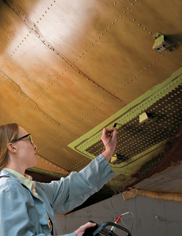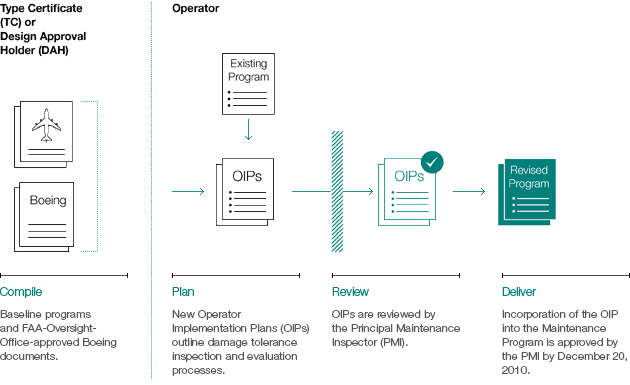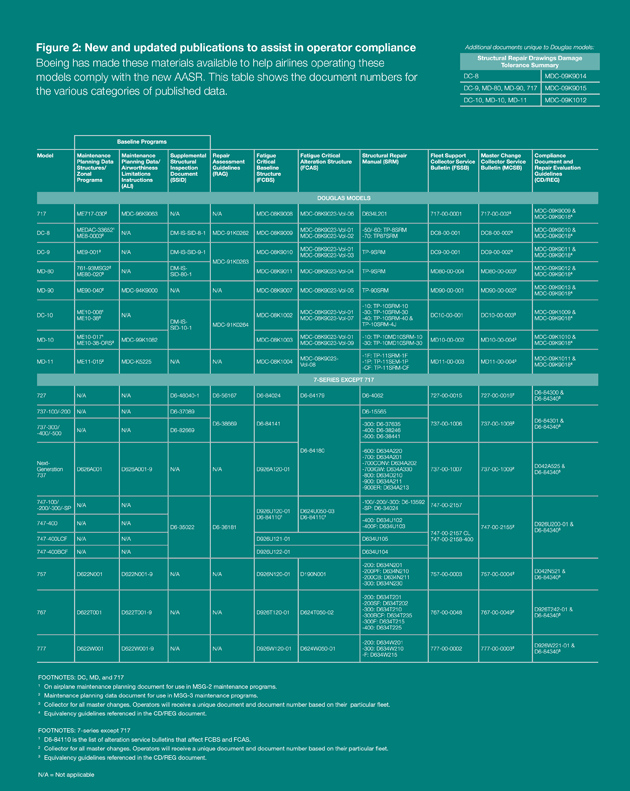

By December 20, 2010, airlines that operate airplanes under Title 14 of the Code of Federal Regulations (CFR) 121 or 129 must revise their U.S. Federal Aviation Administration (FAA)-approved structural maintenance program to comply with the FAA’s Aging Airplane Safety Rule (AASR). This revised maintenance program must include damage-tolerance-based inspections; a means to address the effects that repairs, alterations, and modifications may have on fatigue-critical structure and these inspections; and a means by which all changes to the maintenance program receives FAA approval. Boeing has developed materials to help operators comply with this new rule.
By Roxanne M. Pillo, AASR Deputy Program Manager, Fleet Support Engineering Airframe, and
Amos Hoggard, Technical Fellow (Retired), AASR Program
After December 20, 2010, airplane operators must ensure that all new repairs to fatigue-critical structure receive a damage tolerance evaluation.
The Aging Aircraft Safety Act of 1991 passed by Congress in 1991 — and later codified by the FAA as the AASR — requires airlines to ensure that repairs or modifications made to their airplanes are damage-tolerant. As part of the requirement, airlines must have a damage-tolerance-based maintenance program in place by December 20, 2010. This includes the development of an FAA-approved Operator Implementation Plan that contains the processes and timelines the operator will use for obtaining and incorporating maintenance actions to address the effects of repairs and alterations.
In order to comply with the AASR, operators will need to reassess their structural maintenance program and the way repair approvals are being considered. Retroactive aspects to this rule require surveys of all active airplanes for the purpose of documenting existing repairs, alterations, and modifications requiring damage tolerance inspections. Specific time periods have been established to obtain the inspection requirements for existing repairs, alterations, and modifications that currently lack the required damage tolerance inspections.
At least 4,000 airplanes (U.S.-registered) and 240 operators are affected by this new rule. While only U.S.-registered airplanes are affected at this time, the number of affected airplanes could more than double if the FAA rule is adopted by other regulatory agencies, including the European Aviation Safety Agency and Transport Canada. Currently, some operators of non-U.S.-registered airplanes intend to voluntarily comply with the AASR.
Boeing, working with the industry, has developed FAA-approved methods of compliance to help operators meet the terms of the new rule. The AASR-required changes are complex and require significant revision to the processes and procedures contained in existing maintenance programs. This article provides regulatory background about the new rule, key provisions of the AASR, the compliance method developed by the commercial airline industry, and the information developed by Boeing to support operator compliance with the new rule.
Regulatory background and requirements
The AASR was published, in part, to satisfy the Aging Aircraft Safety Act of 1991. The act requires air carriers to demonstrate that maintenance of an airplane’s age-sensitive parts and components has been “adequate and timely enough to ensure the highest degree of safety.”
The AASR requires operators to have a damage-tolerance-based structural maintenance program for each applicable transport category airplane operated in 14 CFR 121 and U.S.-registered airplanes operated in 14 CFR 129. The requirement extends to the fatigue-critical structure of the baseline, as-delivered airplane structure, as well as to existing and future repairs and alterations that affect fatigue-critical structure. The rule affects all Boeing 7-series, MD, and DC turbofan-powered transport category airplanes. Operators must comply with this rule by December 20, 2010.
Operators are expected to develop and gain FAA approval of an Operator Implementation Plan that details how the operator will comply with the requirements of the operational rules. This plan will consist of both new and existing operator-specific processes the operator will use in demonstrating compliance, including:
- A process to identify repairs and alterations that will require damage tolerance inspections. (The FAA defines damage tolerance inspections as maintenance actions necessary to detect or preclude fatigue cracking that could contribute to catastrophic failure. Damage tolerance inspections are developed as a result of a damage tolerance evaluation.)
- A process to obtain the inspection data and perform the needed inspections.
- A process to conduct surveys of airplanes to determine whether existing repairs will require damage tolerance inspections.
To facilitate operator compliance to the operational rules and to assist in operator development of their implementation plan, the FAA also has required type certificate holders and design approval holders to make available certain new and updated information under 14 CFR 26, Subpart E, including:
- Documents defining fatigue-critical structure.
- Fatigue-critical baseline structure lists.
- Fatigue-critical alteration structure lists.
- Updated published information with damage-tolerance-based maintenance data for items affecting fatigue-critical structure, including:
- Structural repair manuals.
- Fleet-support service bulletins.
- Master-change service bulletins.
- Supplemental type certificates.
- Model-specific compliance documents that contain a repair evaluation guideline.
Key provisions affecting operators
New repair approvals to fatigue-critical structure. As of January 11, 2008, this covers any new or significantly revised repair, master-change service bulletin, or supplemental type certificate approved by Boeing on behalf of the FAA required and contained damage tolerance inspections. Operators must adopt the damage tolerance provisions provided in the approval paperwork for these repairs and alterations for all new installations after January 11, 2008. After December 20, 2010, it is the operators’ responsibility to ensure that all new repairs to fatigue-critical structure receive a damage tolerance evaluation and are properly documented in the damage-tolerance-based maintenance program.
Existing repairs. Existing repairs are defined as those installed prior to December 20, 2010, that affect fatigue-critical structure and do not have approvals indicating a damage tolerance evaluation and the resulting damage tolerance inspections require further action. Operators are expected to identify and document these repairs via an airplane survey. All airplanes delivered prior to December 20, 2010, will require a survey to determine repairs to fatigue-critical structure that do not have damage tolerance inspections. The operator’s implementation plan will need to define how they will obtain and implement the damage tolerance inspections for these repairs.
Existing alterations. Existing alterations are those installed prior to December 20, 2010, that affect fatigue-critical structure and do not have approvals indicating a damage tolerance evaluation and the resulting damage tolerance inspections require further action. Operators are expected to utilize the information provided by Boeing or other design approval holders to ensure that a damage-tolerance-based maintenance program exists for all existing alterations.
An industry-developed method of compliance
Boeing participated in the Airworthiness Assurance Working Group (AAWG) to establish a method of compliance that could be broadly supported by all stakeholders. The AAWG developed the initial draft of the FAA’s advisory circular for this rule, AC 120-93. Boeing continues to participate in the AAWG to enable resolution and awareness of compliance issues at an industry level throughout the implementation of this rule.
After the final rule was published, Boeing organized and held five model-specific Structures Task Group (STG) meetings to guide development of the Boeing documents that operators would use to assist them in the development of their implementation plan. The groups were organized according to AAWG guidelines, and each STG had representation of approximately 60 percent of the active airplanes in a specific airplane fleet.
The compliance process developed by these groups involves operators using Boeing documents and their existing maintenance programs to develop operator implementation plans. These plans are reviewed and approved by the operator’s FAA principal maintenance inspector (or local regulatory authority). The plan is then used as a means by which the damage tolerance data is aggregated and used to revise the maintenance program after December 20, 2010 (see fig. 1).
Figure 1: AASR compliance process
Operators use Boeing documents and their existing maintenance programs to develop implementation plans.

Information for operators provided by Boeing
Boeing has developed FAA-approved methods of compliance to support operator compliance. As part of this effort, Boeing is making available both new and updated model-specific material to help ensure operator compliance with AASR (see fig. 2). The model-specific information is currently available for purchase on the Web portal MyBoeingFleet.com unless otherwise noted.
[+] EnlargeCompliance document and repair evaluation guidelines. The FAA required Boeing to make available an FAA-approved compliance document and repair evaluation guidelines to assist an operator in establishing damage-tolerance-based maintenance programs for existing repairs to fatigue-critical structure. This document is model specific and provides requirements for the operator to perform surveys and establish damage-tolerance-based maintenance programs for existing repairs using the Boeing data listed below. In addition, the document establishes time periods for a variety of actions to be accomplished, including:
- Completion of surveys.
- Determination of damage tolerance inspections.
- Accomplishment of first inspections.
- Available grace periods.
Fatigue-critical structure. Boeing has made available lists of fatigue-critical baseline structure for all affected models. The FAA has defined fatigue-critical structure as “airplane structure that is susceptible to fatigue cracking that could contribute to a catastrophic failure. [It] includes structure that, if repaired or altered, could be susceptible to fatigue cracking and contribute to a catastrophic failure. Such structure may be part of the baseline structure or part of an alteration.” Operators can use the lists provided by Boeing to determine whether a repair or an alteration requires a damage tolerance evaluation and the development of damage tolerance inspections. Boeing has also made available lists of fatigue-critical alteration structure for those master changes and supplemental type certificates held by Boeing.
Published data. Boeing has updated published repair and alteration data for all applicable models to include damage tolerance inspections. This includes structural repair manuals, fleet-support service bulletins, master-change service bulletins, and Boeing-held supplemental type certificates. The damage tolerance inspections for service bulletins have been published in a single service bulletin collector document for each airplane model. In the future, when individual service bulletins (listed in the service bulletin collector document) are revised, the damage tolerance inspection information will be included in the new release and the information in the collector document will no longer apply. (Collector documents for master-change service bulletins will be generated upon request and customized to reflect operator-specific configurations. Operators purchase a master-change collector document by submitting a request for proposal to Boeing.)
Boeing AASR seminar. Boeing is also conducting AASR seminars focusing on the steps necessary to establish compliance with the new operational rules and the Boeing publications developed to support operator compliance. Availability can be found at http://active.boeing.com/nosearch/svceng/seminars.cfm.
Summary
A major change to structural maintenance programs for all 7-series, DC, and MD transport category airplanes operated under CFR 121 and 129 will be required on December 20, 2010. The FAA rule change requires operators to have damage-tolerance-based maintenance programs for affected transport category airplanes and requires a physical survey of airplanes to obtain damage tolerance data for repairs and alterations.
Boeing has published new and updated material to help operators comply with this new rule. All Boeing data needed by operators to comply with the new rule is available for purchase on MyBoeingFleet.com, except for customized master-change service bulletins, which are available by request. Boeing is conducting seminars on this subject.
For more information, please contact Roxanne Pillo.


